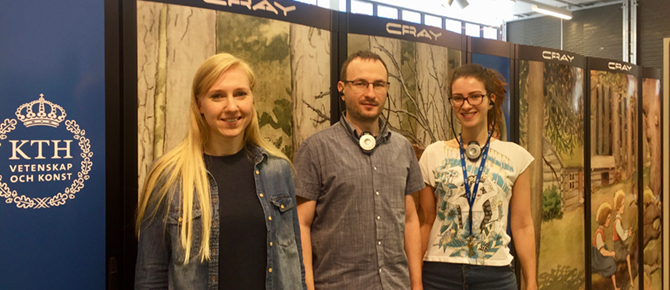Visit from Vilnius via HPCE3
Lilit Axner, PDC

As part of the HPC-Europa3 program, PDC hosted two visitors from Lithuania during June and July 2018. Dr. Kestutis Aidas is an experienced researcher from the Institute of Chemical Physics, Faculty of Physics, at Vilnius University. Dr. Aidas and his Ph.D. student, Dovilé Lengvinaitė, wanted to visit Prof. Aatto Laaksonen at the Department of Materials and Environmental Chemistry, Stockholm University, Sweden.
Dr. Aidas had collaborated with Prof. Laaksonen previously when Dr. Aidas was a postdoctoral researcher at the KTH Royal Institute of Technology in 2011. More recently Dr. Aidas and Ms. Lengvinaitė have been working with Prof. Laaksonen on the theoretical modelling of nuclear quadrupolar coupling constants relevant in the field of nuclear magnetic resonance (NMR) relaxation using molecular dynamics (MD) simulations and combined quantum mechanics/molecular mechanics (QM/MM) approaches. When Dr. Aidas and Ms. Lengvinaitė learned about the funding that the HPC-Europa3 project provides for collaborative research visits, they considered it to be an excellent opportunity for them to continue and strengthen their collaboration with Prof. Laaksonen, since it would enable them to directly discuss matters in person and also to use the high-end computing facilities at KTH-PDC.

To model NMR properties of liquid-state molecules, one often relies on the so-called supermolecular approach. This procedure involves geometry optimisation of the molecular complex composed of the target molecule and a few important solvent molecules, for example, those that are hydrogen-bonded to the target molecule. The entire molecular complex could also be embedded in some kind of dielectric continuum, which is used to account for bulk solvent effects. The NMR properties are then calculated for this geometry-optimised complex using the now standard gauge-including atomic orbital (GIAO) technique to remove gauge-origin dependence of the NMR shielding constants. The supermolecular approach is certainly cost-effective, and reasonably accurate results are often obtained. However, this scheme suffers from a poor description of the long-range electrostatic intermolecular interactions because the discrete nature of solvent molecules is neglected by the continuum approaches. Moreover, dynamical and temperature effects are neglected since the geometry optimised structure represents just a single point on the multidimensional potential energy surface.
These problems can be very effectively dealt with by using an integrated approach where classical MD simulations are combined with the hybrid QM/MM model for the calculation of the NMR properties. MD simulations make it possible to sample the phase space of the molecular system under proper thermodynamic conditions, whereas QM/MM approaches account for anisotropic distribution of the solvent molecules around the solute in the calculation of the electronic response properties. Moreover, a large number of solvent molecules can be easily included in the QM/MM calculation so that the effects of electrostatic interactions are converged. Mutual solute-solvent polarization interactions are accounted for by using explicitly polarizable force fields in the QM/MM calculations. Short-range Pauli repulsion can also be considered by extending the quantum mechanically treated region to include some of the solvent molecules along with the solute. However, there is a price to be paid for the increased accuracy of the model due to the fact that a large number of similar QM/MM calculations (for the molecular snapshots recorded during the MD simulation) need to be performed, typically on the order of around 100.
It was clear that, in order to achieve their goals, extensive MD simulations on the time scale of nearly 100 ns had to be performed for the ionic liquid-water mixtures, including several hundred ionic pairs while varying the number of water molecules. Thus Dr. Aidas and Ms. Lengvinaitė applied to the HPC-Europa3 third call, and were glad that their application was successful.
Dr. Aidas’ and Ms. Lengvinaitė’s visit to Sweden lasted eight weeks in total, and KTH-PDC was the host centre that provided them with accommodation, office space, and also 257,000 CPU hours of runtime on KTH-PDC’s Cray XC40 system (which is called Beskow). By working at the PDC premises, they also had a great opportunity to interact with the high performance computing (HPC) experts at the centre, although the major motivating factor for their application was the potential to collaborate in person with Prof. Aatto Laaksonen, who is a world-renowned expert in classical MD simulations. They benefited from Prof. Laaksonen's experience in simulations of room temperature ionic liquids (RTIL), which is an area where they lack expertise at Vilnius University.
Furthermore, these types of calculations necessitate the extensive use of high-performance computing resources, which Dr. Aidas and Ms. Lengvinaitė had access to via KTH-PDC’s facilities during their visit. This was significant as Dr. Aidas’ team did not have the means to perform this important – yet computationally very costly – modelling at Vilnius University.
After the visit Dr. Aidas pointed out that the “HPC-Europa3 programme has several strong points:
- It provides access to top class computational resources.
- The formalities and paperwork involving the application, actual stay and report are reasonable.
- The entire process is managed so well that one can really focus on research activities only.”
Ms. Lengvinaitė reflected: “This visit was very useful to me as a young scientist, Ph.D. student. During this visit, I had the opportunity to work independently, to test different computing capabilities, to meet the challenges. Get acquainted with great scholars and get in touch.”
Further information and details about applying for an HPCE3 exchange can be found at the HPCE3 website www.hpc-europa.eu . Dr. Lilit Axner can assist with applications.